
Jacob Armstead Lawrence was an American painter known for his portrayal of African-American historical subjects and contemporary life. Lawrence referred to his style as "dynamic cubism", although by his own account the primary influence was not so much French art as the shapes and colors of Harlem. He brought the African-American experience to life using blacks and browns juxtaposed with vivid colors. He also taught and spent 16 years as a professor at the University of Washington.
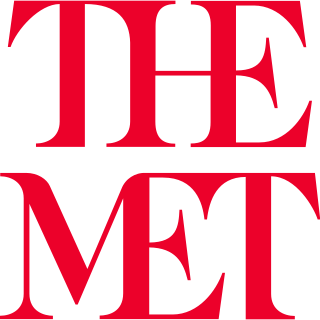
The Metropolitan Museum of Art of New York City, colloquially "the Met", is the largest art museum in the Western Hemisphere. Its permanent collection contains over two million works, divided among 17 curatorial departments. The main building at 1000 Fifth Avenue, along the Museum Mile on the eastern edge of Central Park on Manhattan's Upper East Side, is by area one of the world's largest art museums. A much smaller second location, The Cloisters at Fort Tryon Park in Upper Manhattan, contains an extensive collection of art, architecture, and artifacts from medieval Europe.

The Cathedral Basilica of Saint Louis, also known as the Saint Louis Cathedral, is a cathedral of the Roman Catholic Church located in the Central West End neighborhood of St. Louis, Missouri. Completed in 1914, it is the mother church of the Archdiocese of St. Louis and the seat of its archbishop, currently Mitchell T. Rozanski. The cathedral is named for Saint Louis and was designated a basilica by Pope John Paul II in 1997.
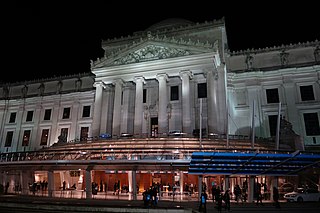
The Brooklyn Museum is an art museum located in the New York City borough of Brooklyn. At 560,000 square feet (52,000 m2), the museum is New York City's third largest in physical size and holds an art collection with roughly 500,000 objects.

The Cleveland Museum of Art (CMA) is an art museum in Cleveland, Ohio, located in the Wade Park District, in the University Circle neighborhood on the city's east side. Internationally renowned for its substantial holdings of Asian and Egyptian art, the museum houses a diverse permanent collection of more than 61,000 works of art from around the world. The museum provides general admission free to the public. With a $755 million endowment, it is the fourth-wealthiest art museum in the United States. With about 770,000 visitors annually (2018), it is one of the most visited art museums in the world.

The Museum of the City of New York (MCNY) is a history and art museum in Manhattan, New York City, New York. It was founded by Henry Collins Brown, in 1923 to preserve and present the history of New York City, and its people. It is located at 1220–1227 Fifth Avenue between East 103rd to 104th Streets, across from Central Park on Manhattan's Upper East Side, at the northern end of the Museum Mile section of Fifth Avenue.

The Smithsonian American Art Museum is a museum in Washington, D.C., part of the Smithsonian Institution. Together with its branch museum, the Renwick Gallery, SAAM holds one of the world's largest and most inclusive collections of art, from the colonial period to the present, made in the United States. The museum has more than 7,000 artists represented in the collection. Most exhibitions take place in the museum's main building, the old Patent Office Building, while craft-focused exhibitions are shown in the Renwick Gallery.

El Museo del Barrio, often known simply as El Museo, is a museum at 1230 Fifth Avenue in Upper Manhattan, New York City. It is located near the northern end of Fifth Avenue's Museum Mile, immediately north of the Museum of the City of New York. Founded in 1969, El Museo specializes in Latin American and Caribbean art, with an emphasis on works from Puerto Rico and the Puerto Rican community in New York City.

The Africa Center, formerly known as the Museum for African Art and before that as the Center for African Art, is a museum located at Fifth Avenue and 110th Street in East Harlem, Manhattan, New York City, near the northern end of Fifth Avenue's Museum Mile. Founded in 1984, the museum is "dedicated to increasing public understanding and appreciation of African art and culture." The Museum is also well known for its public education programs that help raise awareness of African culture, and also operates a unique store selling authentic handmade African crafts.
The Dahesh Museum of Art is the only museum in the United States devoted to the collection and exhibition of European academic art of the 19th and 20th century. The collection, located in Manhattan, New York City, originated with Lebanese writer and philosopher Salim Moussa Achi (1909–1984), whose pen name was Dr. Dahesh. The core of the museum's holdings consists of Dahesh's collection of more than 2,000 academic paintings, which includes many notable Orientalist paintings.

Julie Mehretu is an American contemporary visual artist, known for her multi-layered paintings of abstracted landscapes on a large scale. Her paintings, drawings, and prints depict the cumulative effects of urban sociopolitical changes.
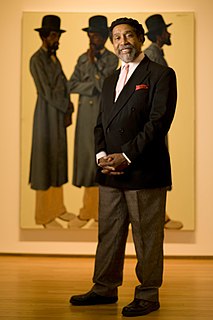
Barkley L. Hendricks was a contemporary American painter who made pioneering contributions to Black portraiture and conceptualism. While he worked in a variety of media and genres throughout his career, Hendricks' best known work took the form of life-sized painted oil portraits of Black Americans.
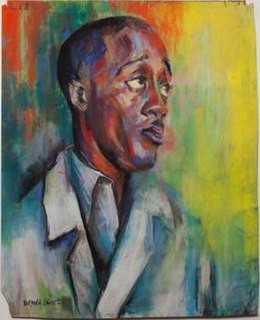
Norman Wilfred Lewis was an American painter, scholar, and teacher. Lewis, who was African-American and of Bermudian descent, was associated with abstract expressionism, and used representational strategies to focus on black urban life and his community's struggles.

FusionArts Museum(s), first founded at 57 Stanton Street on Manhattan's Lower East Side are a series of curated exhibition spaces dedicated to the exhibition and archiving of "fusion art". The museum was and remains at its successive locations a not-for-profit gallery operated by Converging Arts Media Organization, a not-for-profit arts organization which promotes emerging American and international fusion artists. Though the initial space in Manhattan was converted into a commercial art gallery in 2012 and is currently not operating as a Fusionarts museum, other spaces in Prague, Czech, Republic and Easton, Pennsylvania are.

Emerson John Moore was an African-American prelate of the Roman Catholic Church. An auxiliary bishop of the Archdiocese of New York (1982–1995), he was the first African American monsignor and the first to serve as a Catholic bishop in New York. He was also one of the first and only Catholic bishops publicly known to have died of HIV/AIDS complications.

The Church of St. Joseph of the Holy Family is a Black Catholic parish church of the Roman Catholic Archdiocese of New York, located at 401 West 125th Street at Morningside Avenue in the Harlem neighborhood of Manhattan, New York City. It is the oldest existing church in Harlem and above 44th Street in Manhattan. On June 28, 2016, it was designated a New York City Landmark.
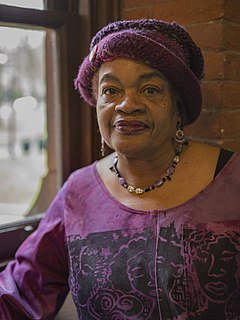
Dindga McCannon, born July 31, 1947, is an African-American artist, fiber artist, muralist, teacher author and illustrator.

Simone Leigh is an American artist from Chicago who works in New York City in the United States. She works in various media including sculpture, installations, video, performance, and social practice. Leigh has described her work as auto-ethnographic, and her interests include African art and vernacular objects, performance, and feminism. Her work is concerned with the marginalization of women of color and reframes their experience as central to society. Leigh has often said that her work is focused on “Black female subjectivity,” with an interest in complex interplays between various strands of history.

Jennie C. Jones is an African-American artist living and working in Brooklyn, New York. Her work has been described, by Ken Johnson, as evoking minimalism, and paying tribute to the cross-pollination of different genres of music, especially jazz. As an artist, she connects most of her work between art and sound. Such connections are made with multiple mediums, from paintings to sculptures and paper to audio collages. In 2012, Jones was the recipient of the Joyce Alexander Wien Prize, one of the biggest awards given to an individual artist in the United States. The prize honors one African-American artist who has proven their commitment to innovation and creativity, with an award of 50,000 dollars. In December 2015 a 10-year survey of Jones's work, titled Compilation, opened at the Contemporary Arts Museum in Houston, Texas.
Paul Claude Gardère was a Haitian-born, Brooklyn-based visual artist whose work explored "post-colonial history, cultural hybridization, race, and identity, in and beyond the Haitian diaspora." Gardère's work has been widely exhibited throughout the United States, including at institutions such as the Studio Museum in Harlem, the Figge Art Museum, Lehigh University, Pomona College Museum of Art, and the Jersey City Museum, and is included in a number of prominent institutional collections, including that of Thea Museum of Modern Art in New York, the Studio Museum in Harlem, the Brooklyn Museum, the New Orleans Museum of Art, Schomburg Center for Research in Black Culture, The Milwaukee Art Museum, the Figge Art Museum, the Columbus Museum, the Beinecke Library at Yale University and the Herbert F. Johnson Museum of Art at Cornell University.



















